Until 1898, Guam was under the control of Spain, so the official flag of the island was Spanish. Spain visited Guam in 1565 during the expeditions of General Miguel Lopez de Legazpi, but officially took control of the island in 1668. After the Spanish-American War, when the United States gained control of the island, the American flag flew over Guam. It is known that in the period from 1896 to 1908, the US flag consisted of 45 states, i.e. 45 stars were placed on the flag, so this version of the flag was used in Guam at that time.

In 1917, the idea to create its own flag for the island came up, and there are several versions of how this happened. According to one of them, the author was a local artist Francisco Feja, who in the 1910s created a series of drawings that reflected the life and nature of Guam. Among them was an image of a boat (proa) on a beach with a palm tree, which became the basis for the coat of arms and flag of Guam. According to another version, the flag was designed by Helen Paul, the wife of Commodore Carrol E. Paul, who made several sketches of Guam landscapes, including a palm tree and a boat on the sea. Regardless of its exact origins, the flag design was approved by Military Governor Roy Smith in 1917, and it was first raised on July 4, 1918, during a ceremony in Hagåtña. In the 1930s, the flag was officially adopted by the administration of Guam.

During World War II, Guam was occupied by Japanese troops from 1941 to 1944. During this period, American symbols, including the flag, were banned, and the flag of Japan was used instead. However, in 1944, the island was liberated by American troops and the Guam flag was restored. In 1948, important changes were made to the flag design: a red border was added around the perimeter. This change symbolized the blood shed during the war and emphasized the island's struggle for freedom. The details of the colors of the coat of arms and the proportions of the flag were also clarified. Since then, the flag has remained unchanged and continues to be used as one of the main symbols of Guam.





